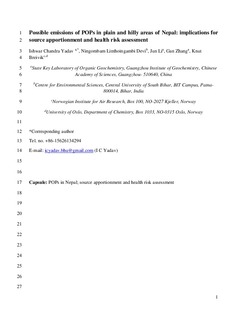| dc.contributor.author | Yadav, Ishwar chandra | |
| dc.contributor.author | Devi, Ningombam linthoingambi | |
| dc.contributor.author | Li, Jun | |
| dc.contributor.author | Zhang, Gan | |
| dc.contributor.author | Breivik, Knut | |
| dc.date.accessioned | 2017-12-04T11:53:10Z | |
| dc.date.available | 2017-12-04T11:53:10Z | |
| dc.date.created | 2016-11-20T11:38:34Z | |
| dc.date.issued | 2017 | |
| dc.identifier.citation | Yadav, I.C., Devi, N.L., Li, J., Zhang, G., & Breivik, K. (2017). Possible emissions of POPs in plain and hilly areas of Nepal: Implications for source apportionment and health risk assessment. Environmental Pollution, 220, 1289-1300. doi:10.1016/j.envpol.2016.10.102 | nb_NO |
| dc.identifier.issn | 0269-7491 | |
| dc.identifier.uri | http://hdl.handle.net/11250/2468996 | |
| dc.description.abstract | Ambient air is a core media chosen for monitoring under the Stockholm Convention on POPs. While extensive monitoring of POPs in ambient air has been carried out in some parts of the globe, there are still regions with very limited information available, such as some developing countries as Nepal. This study therefore aims to target the occurrence of selected POPs in Nepal in suspected source areas/more densely populated regions. Four potential source regions in Nepal were furthermore targeted as it was hypothesized that urban areas at lower altitudes (Birgunj and Biratnagar located at approximately 86 and 80 m.a.s.l.) would be potentially more affected by OCPs because of more intensive agricultural activities in comparison to urban areas at higher altitudes (Kathmandu, Pokhara located 1400 and 1135 m.a.s.l). As some of these areas could also be impacted by LRAT, air mass back trajectories during the sampling period were additionally evaluated using HYSPLIT. The concentrations of overall POPs were twice as high in plain areas in comparison to hilly areas. DDTs and HCHs were most frequently detected in the air samples. The high p,p'-DDT/(pp'-DDE + pp'-DDD) ratio as well as the low o,p'-DDT/p,p'-DDT ratio observed in this study was inferred as continuing use of technical DDT. High levels of Sum26PCBs were linked to proximity to highly urbanized and industrial areas, indicating the potential source of PCBs. The measured concentrations of legacy POPs in air from this study is assumed to represent a negligible health risk through inhalation of ambient air, however, other modes of human exposure could still be relevant in Nepal. The air mass backward trajectory analysis revealed that most of the air masses sampled originated from India and the Bay of Bengal. | nb_NO |
| dc.language.iso | eng | nb_NO |
| dc.rights | Attribution-NonCommercial-NoDerivatives 4.0 Internasjonal | * |
| dc.rights.uri | http://creativecommons.org/licenses/by-nc-nd/4.0/deed.no | * |
| dc.title | Possible emissions of POPs in plain and hilly areas of Nepal: Implications for source apportionment and health risk assessment | nb_NO |
| dc.type | Journal article | nb_NO |
| dc.type | Peer reviewed | nb_NO |
| dc.description.version | acceptedVersion | nb_NO |
| dc.rights.holder | © 2016 Elsevier Ltd. All rights reserved | nb_NO |
| dc.source.pagenumber | 1289-1300 | nb_NO |
| dc.source.volume | 220 | nb_NO |
| dc.source.journal | Environmental Pollution | nb_NO |
| dc.identifier.doi | 10.1016/j.envpol.2016.10.102 | |
| dc.identifier.cristin | 1402098 | |
| dc.relation.project | Norges forskningsråd: 213577 | nb_NO |
| cristin.unitcode | 7460,57,0,0 | |
| cristin.unitname | Atmosfære og klima | |
| cristin.ispublished | true | |
| cristin.fulltext | postprint | |
| cristin.qualitycode | 1 | |

